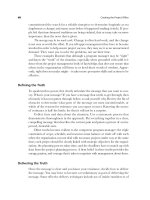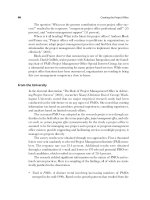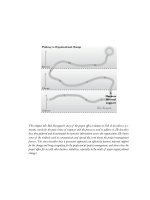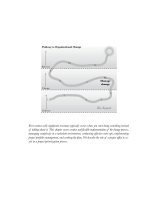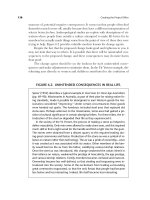Creating the project office 12
Bạn đang xem bản rút gọn của tài liệu. Xem và tải ngay bản đầy đủ của tài liệu tại đây (80.26 KB, 10 trang )
a working session of the Top 500 Project Management Benchmarking Forum held
in Milwaukee, Wisconsin, in 1996 (Toney, 2002). (The benchmarking forums are
held two to four times a year under the coordination of Frank Toney, director of
the Executive Initiative Institute, Scottsdale, Arizona. The sessions serve to gather
information on best practices and stimulate an exchange of ideas on the practice
of project management.) After considerable debate the thirty representatives who
met in Milwaukee came to consensus that the basic project office types are indeed
the PSO, PMCOE, and PMO.
Variations
Although the PSO, PMCOE, and PMO groupings are helpful for discussion pur-
poses, in practice POs are rarely just alike—even if they are part of the same cate-
gory. The functions described separately may fuse together into different forms. For
instance, the staff functions of the PSO and the PMCOE might merge, even though
the PSO is inwardly targeted, and the PMCOE is aimed at scanning the outside en-
88 Creating the Project Office
FIGURE 4.2. CHIEF PROJECT OFFICER.
CPO
Strategic
project planning
Project
reviews
Priorities and
resources
Business
decisions on
new projects
Oversight of
strategic
projects
Top management
and stakeholder
interfacing
Project management
awareness and
capability
Oversight of
enterprise-wide
project management
system
vironment to continuously improve methodologies and PM approaches. If those
differing thrusts can be combined under the guidance of one group, then that hy-
brid form is perfectly feasible. Other possibilities include incorporating staff sup-
port functions with a PMO. Another variation couples the PMCOE with the CPO.
A Vision and a Strategy for the Project Office
To focus on the right concept and properly design a project office, consider sev-
eral angles, since no one-size-fits-all PO can accommodate the characteristics of
every organization. Here are questions designed to raise fundamental issues prior
to initiating design of the organization:
• What is the size of the organization that the project office is to serve? Is it global or oth-
erwise geographically widespread? Or is it local and concentrated? Or is the
target audience only a part of the entire organization?
• What are the desired outputs of the project office? Information for management? Sup-
port and internal consulting for projects? Standardization of methodologies?
Implementation of cutting-edge technologies? Stakeholder articulation?
• What are the probable roadblocks to implementing the concept in the organization? Lack of
upper management support? Strong resistance from the grass roots? Underes-
timating of change management necessary to implement the concept?
• What is peculiar about the organization that will facilitate or hinder the PO concept? Is the
company project-driven by nature (construction, software development) or is
it product-driven (soap, furniture)?
These fundamental questions set the backdrop for the project office design
process covered in this chapter. Once the underlying issues have been addressed,
a detailed approach is called for. This means analyzing the dozens of variables
that affect project office design and the subsequent performance of the PO. Fig-
ure 4.3 lists the possible variables.
After the project office design parameters are pinned down, the next step is
to formally define them. This may be conventionally registered in the form of
written documents:
• Charter
• Internal organization and external interfaces
• Policies and procedures
• Roles, responsibilities, and position descriptions
• Competency and training requirements
Focus 89
90 Creating the Project Office
FIGURE 4.3. FOUR CLASSES OF PO DESIGN VARIABLES.
Class Variables Options
1. Context The need for a PO Market-driven? Internally driven?
The articulators Top management? Specific area?
Cross-functional?
Company background Project-driven? Functional? Other?
Implementation intent Revolutionary or evolutionary?
Intended scope of PO Purely for implementation?
Tied to business strategy?
2. Organization Management Premise Line or staff function?
and People
Direct authority CEO? Department head? Committee?
Scope of projects All projects? Major projects?
Area project?
People for projects Recruits? Trainees? Allocates? Supports?
Size Large group? Mostly virtual?
3. Support Methodologies Develop? Implement? Monitor?
Functions
Tools Select? Adapt? Train?
Records maintained For all projects? Priority projects?
Type of support? Proactive? Support when asked?
4. Project Tracking and reporting All-inclusive for management?
Execution
Project by project?
Auditing Support function to PMs?
For management control?
Planning and scheduling Support to projects?
Hands on on-site assignments?
Communications On enterprise basis?
Single project support?
Change management Proactive management?
Supply procedures?
Just as in the case of any other project implementation, starting up a project
office requires a logical sequence of actions. The project involves not only techni-
cal issues but challenges of a behavioral and political nature. Here is the sequence:
1. Assessment and conceptual design. Assess current project management practices and
develop a concept that will be coherent with company needs.
2. Detailed design and solution development. Develop each part of the solution, including
methodology and processes, software and system requirements, and organi-
zational aspects.
3. Pilot testing. Test the proposed solutions on a specific project to obtain buy-in
and improve the solutions.
4. Implementation. Initiate use of the solutions on a broader scale. This phase in-
cludes the behavioral side of change management as well as technical imple-
mentation.
5. Maintenance. Manage the processes implemented to ensure optimum perfor-
mance and maintain training to develop full engagement.
Indeed, the project office is an enterprise-wide solution for tracking multiple
projects and for maintaining focus on company strategies, yet designing a PO pre-
sents sizable challenges because of the number of variables involved. The PO
function varies in scope from purely strategic to operational support to full line
responsibility for completed projects. The PO’s physical size may range from mi-
nuscule to grandiose, and the operating philosophy may often be more virtual
than real.
Consider also the norms in the organization around terms used to describe
activities. One implementation struggled when its designers rolled out a pilot ver-
sion, thinking of it as a prototype that would help get feedback about the design.
The problem was that most of the participants expected a pilot to be almost ready
to go, the first implementation of the final product, so they were horrified about its
weaknesses. A different iteration of a project office got a better reception when it
used the term experiment, which had few existing expectations in the organization,
to describe a trial run. New terms may help avoid the baggage associated with ex-
isting vocabulary.
The success of the final design is measured by the degree to which the PO
shines a powerful spotlight on project management in the organization and en-
sures that projects perform within procedures and in line with organizational
strategies. Meeting that goal requires customization based on the design questions
and parameters outlined. Unquestionably, custom tailoring is the way to go, since
in the case of the project office, one size does not fit all!
Focus 91
After the Giant Step:
Communication and Building Commitment
Mapping out the vision and strategy for the project office, using the variables and
options just described, is a giant step in the right direction; it makes implement-
ing a productive project office much more likely. Yet it is not enough to actually
make it happen. Although coming up with the right PO concept is indeed a crit-
ical success factor, the way the view is communicated and sold to the rest of the
organization is equally important.
Whereas formulating the concept of a project office function is primarily an
intellectual process, communicating and selling the idea resides in the behavioral
field. It involves factors like reaction to change, human ego, turf struggles, and al-
lowance for time to absorb new concepts. So once the PO concept has been
hatched (PSO, PMCOE, PMO, CPO or one of the sundry other variants), then
careful planning goes into how to garner the needed support to make the idea
come to life.
To implement any new concept—especially one as complex as a PO—it is
useful to start by putting in place a process for understanding, acceptance, and
buy-in with the principal stakeholders: the project managers, vice presidents, func-
tional managers, and support staff. To develop understanding, people have to be
exposed to the idea and then process it over a period of time, all in their own per-
sonal style. This may involve listening to a talk on the topic, participating in a
workshop, surfing the Web for more details, reading about it in the literature, and
discussing it in detail with colleagues. The process will take weeks for some peo-
ple and months for others, just to understand what the PO is supposed to do.
To get people to accept the concept involves dealing with other issues. Here
stakeholders struggle with these questions:
• How will the PO affect my present status?
• What’s in it for me?
• Will someone be trying to control what I do?
• What risks will I run by supporting the proposed PO?
• Who else is in favor of the idea?
• How does the PO affect internal politics?
Once again, it takes time for people to find answers and move on to full
acceptance.
Buy-in for the PO means that stakeholders understand and accept the con-
cept and are ready to put it into practice. For this to happen, a number of prerequi-
92 Creating the Project Office

